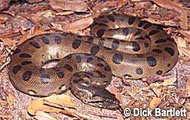What happens when an animal gets classified as injurious under the Lacey Act, such as with S. 373?
 The green anaconda would be added to the injurious wildlife list of the Lacey Act should S. 373 pass as written. |
By now most of you reading this are probably used to hearing about bill Senate Bill 373. Like H.R. 669 and other bills before it, S. 373 seeks to restrict the commerce surrounding some popular pet snakes. It has the entire reptile industry up in arms, because if it becomes law, people’s livelihoods will be affected, and perhaps outright destroyed. The United States economy is in enough of a tailspin without this bill wreaking further financial havoc.
I’m not going to go into a detailed history of S. 373 in this blog. If you want additional background read some of my past blogs, as well as Andrew Wyatt’s “The Reptile Nation” blog.
The latest S. 373 development was last week, when the bill was amended on Dec. 10. This did move S. 373 further along the road toward law than any of the other reptile-related bills in recent memory that have not emerged from committee. Prior to being amended, S. 373 sought to add all snakes in the Python genus to the Lacey Act’s list of Injurious Wildlife. This was recognized as wholly ridiculous, which led to the amendment. Now the bill has limited its scope of snake persecution to nine species: four anacondas, two African rock pythons, Burmese and reticulated pythons, and Boa constrictor. So now the bill is a little less ridiculous, but still unwarranted, with the addition of the boa constrictor especially surprising.
If you’ve been reading about S. 373, you’ve seen a lot of the words “Lacey Act” and “injurious wildlife.” The Lacey Act is named after Iowa Congressman John Lacey, who introduced it in the House of Representatives in 1900. It was signed into law by President William McKinley that same year. Here is an excerpt from the Animal Legal & Historical Center website page about the Lacey Act:
The Lacey Act, 16 U.S.C. §§ 3371-3378, protects both plants and wildlife by creating civil and criminal penalties for a wide array of violations. Most notably, the Act prohibits trade in wildlife, fish, and plants that have been illegally taken, possessed, transported or sold. Thus, the Act underscores other federal, state, and foreign laws protecting wildlife by making it a separate offense to take, possess, transport, or sell wildlife that has been taken in violation of those laws. … The Lacey Act is administered by the Departments of the Interior, Commerce, and Agriculture through their respective agencies. These include the U.S. Fish and Wildlife Service, National Marine Fisheries Service, and Animal and Plant Health Inspection Service.
If you read the actual text of the Lacey Act, it’s enough to make a layperson’s head swim. It was originally meant to help states protect their indigenous game birds and other animals. It includes provisions for injurious wildlife, and as such a list of animals classified as injurious is maintained. It is onto this list that the advocates for S. 373 seek to add the nine snakes in question.
I’ve also been reading summaries of the provisions to the Lacey Act regarding injurious wildlife. From a U.S. Fish and Wildlife document:
Species are added to the list of injurious wildlife to prevent their introduction or establishment through human movement in the United States to protect the health and welfare of humans, the interests of agriculture, horticulture or forestry, and the welfare and survival of wildlife resources from potential and actual negative impacts.
If an animal is classified as injurious it is illegal to import or export that animal, or transport it across state lines. I’ve been asked whether or not pet snakes already in captivity will automatically become illegal if S. 373 is made into law. That is uncertain, because it appears that the legality of private pets depends on individual state laws, as evidenced by another quote from the same U.S. Fish and Wildlife document:
Regulation of transport or use within a State is the responsibility of each State. Possession of a species, within State boundaries, is also the responsibility of each State and is not regulated by an injurious wildlife listing. (You can read this document in its entirety here.)
Regardless of your state’s laws, for reptile hobbyists, no good will result from adding any reptiles to the Lacey Act’s list of injurious wildlife. The animals could become not just illegal to import, export or move across state lines, but to own, period. Professional reptile breeders will find themselves unable to sell their animals, and they could lose their businesses. Without them, reptile expos could suffer horribly, as well as pet stores and product manufacturers. The pet industry and people working within it will be dealt a severe blow.
Rest assured that the groups that are against the keeping of pet reptiles and who lovingly nurture and endorse bills such as S. 373 won’t stop at the nine snakes being considered as I write this. They will continue their march to push the reptilekeeping hobby into a new role, that of a distant memory. For that reason I urge anyone who enjoys keeping pet reptiles and amphibians to stay informed and to continue voicing their dissent.


